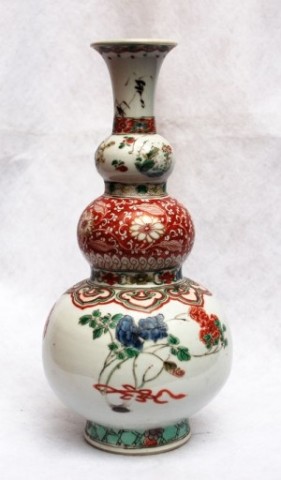Of triple-gourd form, with a short trumpet neck and high, splayed foot, painted in bright famille verte enamels with on the lowest bulb three groups of flowering branches of chrysanthemum, peony and hibiscus each tied with an iron-red ribbon, all set below a collar of ruyi-heads on the shoulder and a narrow band of interlinked flower-heads around the waist, the middle bulb decorated with scrolls of lotus flower highlighted in gold and reserved on an iron-red ground, a further narrow band around its upper waist painted with geometrical motifs, the third, top bulb painted with three medallions shaped as fruits, each exquisitely painted with a small scene of either crickets or a small bug amidst foliage, the neck with a narrow band of interlinked flower-heads and bamboo twigs and further geometrical motifs around the exterior rim, the splayed foot decorated with the cracked-ice motif, the recessed base glazed.
Literature
Footnote: An almost identical triple gourd vase is illustrated in Christiaan J.A. Jorg in collaboration with Jan van Campen, Chinese Ceramics in the Collection of the Rijksmuseum, Amsterdam, published by Phillip Wilson and the Rijksmuseum Amsterdam, London and Amsterdam, 1997, pl. 180, pp. 164-165. Jorg writes about the shape and design of the vase and we quote: This is a carefully painted piece, the contrast between the middle bulb and the other two being something which was apparently favoured on vases and bottles of this period. In Dutch this shape is traditionally called knobbelfles, bulb bottle. Such bottles or vases were much in demand, their complicated form being well suited for decorative purposes in accordance with the trend set by the designs of Daniel Marot. Daniel Marot (1661-1752) was a French Huguenot architect and designer who worked for the Dutch court. Jorg writes how--he massed porcelain on mantelpieces and used it to line mirrors and wall panels, enhancing the overall effect of their shapes and colours. Prints of his designs quickly spread the fashion in the Netherlands and England, where he was also employed by William and Mary. (ibid, p. 135.) Another pair of triple gourd vases but in powder blue are in the collection of Boymans Van Beuningen Museum, Rotterdam, illustrated in Christiaan J.A. Jorg, Famille Verte, Chinese Porcelain in Green Enamels, Groninger Museum, 2011, pl. 105, here Jorg writes how: In Europe, the stacked bulbous shapes appealed to the Baroque taste. In China, there is a long tradition of gourd bottles, often associated with Daoist magic. They were used to store elixirs, and the vapours rising from an open gourd flask could be used to catch demons. The Immortal Li Tieh-kuai carries a double-gourd bottle as one of his emblems. A single similarly shaped triple gourd vase but in iron-red enamels from the Musee Nationale Adrien Dubouch, is illustrated in Christine Shimizu and Laure Schabanne, L'Odyssee de la Porcelaine Chinoise, 2004, no. 149, p. 198.

